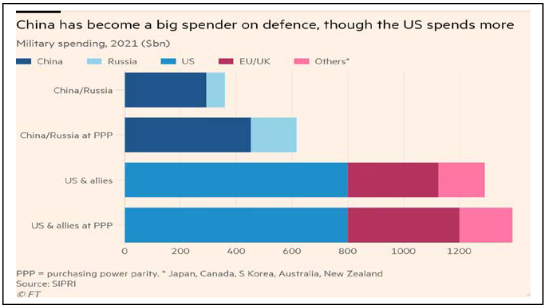As the world transitions from a bi-polar to a multi-polar one, Europe is experiencing a brutal cross-border conflict, the financial markets are in disarray, and the two superpowers are engaged in a new cold war. Fracturing the world’s alliances and echoing the beggar-thy-neighbor protectionist past of the Great Depression, countries have become insular, led by the United States, with trade barriers, guardrails, and nationalistic policies dividing the world. Globalization which once allowed easier access to food, energy, and decades of prosperity, has been replaced by a new reality of deglobalization, reinforcing the inflationary problems of today, which is far from transitory. The largest bond and stock boom in history was then fueled by fifteen years of free money, but this was followed by a hangover of entrenched inflation, rising interest rates, and bank collapses on both sides of the Atlantic. Today, the focus is on the capital wars of a financially strapped United States after fighting two fruitless wars, a pandemic, Russia, and a Green Revolution. America's debt is its Achilles heel, with a debt-to-GDP ratio of 130 percent. Yet America’s challenges are only beginning.
The gravity of the problem is that amidst the turmoil in its financial markets, the US is locked in a great power competition with an ascendant China and unstable Russia, with its defense industry dependent on chips and critical minerals mined by others and debt held by foreign powers. To close the gap, the US has gone on a reckless spending spree in an attempt to bring back industries and technology in a realpolitik world.
Too Big to Fail
The “March Madness” failures of three banking institutions and a fourth, First Republic Bank (OTC:FRCB) sparked new jitters in Washington. A bank run of just $0.04 trillion in a single day brought down Silicon Valley Bank (SVB) and the Federal Deposit Insurance Corporation's (FDIC) $250,000 insurance cap, exposing the structural vulnerability of the US financial system at a time when approximately half of US deposits, or about $2.6 trillion, are uninsured. The FDIC made Silicon Valley Bank's venture capitalists' accounts whole in an effort to prevent the deposit outflow from spreading, which caused the Fed's balance sheet to expand by $300 billion in just one week.
The deposit insurance law was part of a raft of new laws that included thousands of pages of new regulations and the Dodd-Frank reforms, which were designed to stop costly future taxpayer-funded bailouts following the crash of 2008. Further, to save taxpayers money, bail-ins were enacted to shift the risk to unsecured creditors and depositors. Ironically, then Fed Chair Janet Yellen was one of the architects of the series of reforms to protect the system. However, ten years later, the Trump era rollbacks of Dodd-Frank allowed SVB to escape the more onerous stress tests and liquidity requirements. This time, the former Fed Chair and now Treasury secretary, Janet Yellen, guaranteed SVB’s billionaire clients’ deposits, scrapping the “bail-in” provisions. And, worrisome is that the FDIC has less than $100 billion left after taking a $15.8 billion haircut on Silicon Valley Bank and handing over $50 billion to America’s savior of choice, JP Morgan, for taking over the First Republic, raising questions about the safety of the more than $5 trillion of savings which have subsequently moved into money market funds, ironically without FDIC guarantees. Fearful of the threat to the financial sector’s plumbing, Treasury Secretary Yellen warned of “structural vulnerabilities”. Are mattresses any better?
The contagion reached Switzerland where 167-year-old Credit Suisse was the next domino to fall, forcing the Swiss government to provide $120 billion of state backed guarantees to orchestrate a shotgun wedding with archrival UBS, creating the world’s fourth largest megabank along the lines of Goldman Sachs (NYSE:GS). Despite a half-trillion-dollar balance sheet, Credit Suisse was the first collapse of 30 global financial institutions designated as “too big to fail” by the International Financial Stability Board. But by declaring some subordinated $17 billion CoCo notes worthless, the Swiss government wiped out bondholders rather than shareholders and arbitrarily modified the law, upending a long- standing hierarchy that places debt ahead of equity. Contingent convertibles, or CoCos, were designated as Tier I capital to assist in financing the banks following the 2008 crash, with the payment of higher coupon rates to offset the underlying risk. That action alone put the $260 billion derivative market in jeopardy. Again, regulations such as the aforementioned bail-in provisions were scrapped, shifting the liabilities to shareholders and bondholders, leaving depositors intact. Memories are short. In 2008, UBS required a bailout, financed then with taxpayers’ money. Plus ça change ……
Let The Bailouts Begin
Much has been written that it is different this time. Two years ago, Silicon Valley Bank made an unhedged investment in long-term securities during the Fed's low-rate environment. When the bank needed cash to pay depositors during the Fed's cycle of rising rates, the bank was forced to sell, which resulted in a run on the bank. Similarly in 2008 because of a liability mismatch, a $17 billion run on bankrupt Washington Mutual forced the takeover by America’s largest bank JP Morgan for $1.9 billion setting off the sub-prime meltdown that triggered the failures of Lehman Brothers and Bear Stearns.
Financial markets, accustomed to decades of easy money that fueled an “everything bubble”, perversely celebrated on high hopes that the Fed would slowdown rate increases. However as before, similar to the overuse of fiscal policy during and after the pandemic, the bailouts and the dismantling of reforms created more uncertainty and confusion, with taxpayers again on the hook. In the past year, the Fed has raised rates 500 basis points, a process which destabilized SVB and First Republic, sowing the seeds for this current crisis in a scramble for safety and yield. That scramble, and now the banking implosion has raised hopes for a short-term reprieve, but inflation continues to roar ahead. Moreover, the failure of four US banks lights the fuse on a new round of higher inflation because to help the troubled banks, the Fed’s emergency injection of liquidity again uses the nation’s balance sheet to bailout the risk takers, just as they did in 2008, when no banker was held to account. President Biden’s response? “That’s how capitalism works”. The taxpayers are less fortunate.
And as the swamp drains, the ugly frogs have surfaced. One of the first was the US banking system which underpins the US economy and dollar. The banking system is in turmoil, but it is just the tip of the iceberg. Behind the immediate crisis there are more serious structural problems as the government can’t guarantee every deposit in the banking system. Of concern is that Silicon Valley Bank problems are not isolated and that many more failures lie ahead particularly since of the 4,800 or so, regional banks’ and savings institutions’ securities portfolio are an estimated $1.75 trillion underwater or 80% of their capital. Furthermore, it is the banks that are the backbone of the US financial system providing the majority of loans to the all important $6 trillion commercial real estate market where a $1.5 trillion wall of debt needs to be refinanced over the next few years and, at sharply higher rates. Commercial real estate in our opinion is the next shoe to drop. That looming crisis is part of the consequential retreat from lending, together with the mass exodus of bank deposits are the ingredients of a classic credit crunch, requiring additional federal help to bailout the “walking dead”.
Money For Nothing
And not just banks are having problems. Much larger losses are also in store as the bigger frogs in the swamp, their overseers, the Fed and other central banks also purchased trillions of bonds as part of the “prolonged” series of quantitative easing (QE) stimulus programmes. Last year the Swiss National Bank reported a loss of $143 billion or almost 18% of Swiss GDP. Even before the bailouts, the Fed, which has capital of $42 billion, has lost nearly $36 billion since mid-September.The accountants reclassified those central bank losses as “deferred assets”, yet with negative capital and massive losses to come, how will the central banks pay their bills? From past history, central banks could always print more. In 2008, before the housing crisis, the Fed’s balance sheet was only $900 billion. Today after the pandemic and Biden’s spending blowout, the Fed’s balance sheet is at $8.6 trillion. Printing more money won't do anything but increase inflation, which will perpetuate the never-ending boom-and-bust cycle.
While this dynamic is not new, velocity (VIX) is. Recent events are happening much quicker, deeper and the safety net is frayed. We believe that the billions of bailouts and trillions spent on the pandemic on top of the trillions borrowed earlier will only trigger a broader economic crisis, requiring yet another series of market bailouts. And the consequential changing of rules, moving the goal posts, or abrogating laws undermines market discipline, leading to a crisis of confidence in the market. With the world much more interconnected and the banking sector now so big, should we face a synchronized downturn, the rules of the game could change quickly as Credit Suisse and Silicon Valley Bank discovered – they are the canaries in the coal mine.
“Guns and Butter” Era Has Returned
Amid the fallout from the banking turmoil and concerns of a financial meltdown there are anti- government strikes in the UK, Germany, Israel and France with President Macron even postponing a visit by King Charles because of escalating demonstrations. Is the world aflame? To counter the Russian invasion, the world is rearming with the best armed nation increasing military expenditures to almost $900 billion as the military-industrial complex doubles down on the disasters in Afghanistan and Iraq. Today US-led NATO is larger than it was at the start of the war. Such is the breadth of consensus that even Canada has raised military expenditures but far short of the promised two percent target, after spending only 1.2 percent of GDP leaving an armed force consisting of less than 30,000 reserve troops, 40,000 regular troops and four submarines in dry dock.

Meantime, Mr. Biden wants trillions more to reshape America’s industrial strategy to a green society even though its scientists and businesses have expressed doubts about the growth and efficiency of his industrial policy. We believe the weaponization of trade, the impossible task of self-sufficiency, and domestic subsidization is a negative sum game sure to lead to America’s declining global influence as well as an unprecedented surge in fiscal spending and inflation.
